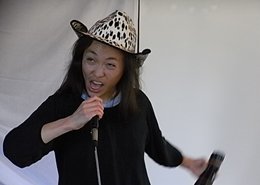In an explanatory programme note, composer Trevor Knight discusses the impetus for The Devil’s Spine Band: that “music and sound would act as the backbone to the performance.” Knight’s boozy bluegrass score is certainly the most coherent element of this unusual cross-cultural collaboration, which brings Knight together with visual artist Alice Maher, actor Olwen Foueré, and two Japanese Butoh dancers, Maki Watanabe and Gyohei Zaitsu.
This is the second time that Knight has come together with Maher, Watanabe and Zaitsu, the first collaboration being 2007's Slat, also at the Galway Arts Festival. The creative starting point for this new project (although it punctuates the end of the performance) is a lecture that Oscar Wilde gave on Aesthetics in Leadville, Colorado in 1882. As Knight explains, “here were opera singers, orchestra, plays, in fact all forms of European High Culture, in this place in the middle of nowhere... [where] miners, gamblers, prostitutes, gunmen, lynchers, Chinese railroad workers etc were living out a parallel shanty town existence.” The idea for The Devil’s Spine Band, then, was to similarly blend high and low cultures – in this case performance art at its most unstructured with an earthy roots-based score. Unfortunately, the result is somewhat impenetrable.
The setting is recognisably the Wild West, and it is no accident that Alice Maher’s gnarled sparkling cacti evoke phallic symbolism; this is essentially a hyper-masculine world and the sound of prairie dogs howling in the distance confirms the environmental threat. Aedín Cosgrove’s strung bare-bulb lighting, meanwhile, is suitably shadowy, and the Radisson’s Live Lounge – located deep in the basement bowels of the hotel – provides a saloon-style setting which might have been better exploited by Knight in his role as director; the audience sit at the periphery of the stage area for the duration, cast as spectators rather than participants in the show.
 The performance elements revolve around disconnected and fragmentary scenes. The action, as such, consists of the two Butoh dancers moving around the stage in various crouched postures and in varying degrees of undress. Zaitsu's near nudity allows the audience to marvel at the muscularity of the dancer's body, but his traditional Butoh movements are not followed through by Watanabe's more fluid rythmic gyrations. Meanwhile, Olwen Foueré stalks around the edges of the stage in a babygro, with a doll’s head positioned at her crotch. Later she appears as a version of the Devil herself, baring her breasts in an Alexander McQueen-inspired lace and feathers number. Some of the images are fairly self-explanatory – a card game, a bar-room brawl. However, they seem to bear no connection to the standard slow movement and masklike howl of the intermittent Butoh sequences provided by Zaitsu. What links the fusion of Eastern and Western imagery most vividly is the lack of any evident humour: the audience’s amusement at the start of the show slowly turns to bemusement, as it becomes clear that this is how the show will continue for more than two hours. On the night I saw it, there were several walk-outs.
The performance elements revolve around disconnected and fragmentary scenes. The action, as such, consists of the two Butoh dancers moving around the stage in various crouched postures and in varying degrees of undress. Zaitsu's near nudity allows the audience to marvel at the muscularity of the dancer's body, but his traditional Butoh movements are not followed through by Watanabe's more fluid rythmic gyrations. Meanwhile, Olwen Foueré stalks around the edges of the stage in a babygro, with a doll’s head positioned at her crotch. Later she appears as a version of the Devil herself, baring her breasts in an Alexander McQueen-inspired lace and feathers number. Some of the images are fairly self-explanatory – a card game, a bar-room brawl. However, they seem to bear no connection to the standard slow movement and masklike howl of the intermittent Butoh sequences provided by Zaitsu. What links the fusion of Eastern and Western imagery most vividly is the lack of any evident humour: the audience’s amusement at the start of the show slowly turns to bemusement, as it becomes clear that this is how the show will continue for more than two hours. On the night I saw it, there were several walk-outs.
Trevor Knight’s score is really excellent, the influences of Johnny Cash and Tom Waits only enhancing its originality. However, the very literal attempt to stage images that the music naturally evokes here reduces rather than enhances the music, and that takes some doing.
Sara Keating writes about theatre for The Irish Times and The Sunday Business Post.